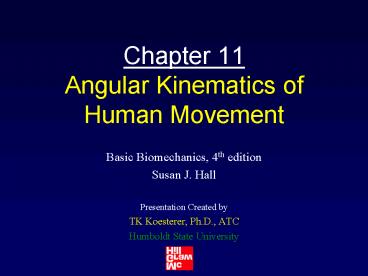Chapter 11 Angular Kinematics of Human Movement - PowerPoint PPT Presentation
1 / 23
Title:
Chapter 11 Angular Kinematics of Human Movement
Description:
Goniometer: One arm fixed to protractor at 00. Other arm free to rotate. Center of goniometer over joint center. Arms aligned over longitudinal axes ... – PowerPoint PPT presentation
Number of Views:685
Avg rating:3.0/5.0
Title: Chapter 11 Angular Kinematics of Human Movement
1
Chapter 11Angular Kinematics of Human Movement
- Basic Biomechanics, 4th edition
- Susan J. Hall
- Presentation Created by
- TK Koesterer, Ph.D., ATC
- Humboldt State University
2
Objectives
- Distinguish angular motion from rectilinear and
curvilinear motion - Discuss the relationship among angular kinematic
variables - Correctly associate associate angular kinematic
quantities with their units of measure - Explain the relationship between angular and
linear displacement, angular and linear velocity,
and angular and linear acceleration - Solve quantitative problems involving angular
kinematic quantities and the relationship between
and linear quantities
3
Observing the Angular Kinematics
- Clinicians, coaches, and teachers of physical
activities routinely analyze human movement - Based on observation of timing and range of
motion - Developmental stages of motor skills are based on
analysis of angular kinematics
4
Measuring Angles
- Filmed images
- Videotapes and films of human movement
- Computer software
5
11-1
6
Relative versus Absolute Angles
- Relative angle
- Anatomical reference position
- Absolute angle
- Horizontal reference
- Vertical reference
7
11-2
8
11-3
9
Tools for Measuring Body Angles
- Goniometer
- One arm fixed to protractor at 00
- Other arm free to rotate
- Center of goniometer over joint center
- Arms aligned over longitudinal axes
- Electrogoniometer (elgon)
- Inclinometers
10
Instant Center of Rotation
- Instant Center
- Roentgenograms (x rays)
- Instrumented spatial linkage with pin fixation
- Example
- Instant center of the knee shifts during angular
movement
11
11-4
12
Angular Kinematic RelationshipsAngular Distance
Displacement
- Assessed as difference of initial final
positions - Counterclockwise is positive
- Clockwise is negative
- Humans also indicate with joint-related
terminology - Measured in
- Degrees, radians, or revolutions
13
Radian
14
Angular Kinematic Relationships Angular Velocity
- Angular velocity angular displacement ? ?
- change in time ?t
- Units deg/s, rad/s, rev/s, rpm
15
Angular Kinematic Relationships Angular
Acceleration
- Angular acceleration change in angular velocity
- change in time
- ? ? ?
- ?t
- Units deg/s2, rad/s2, rev/s2
16
Angular Kinematic Relationships
- Angular Motion Vectors
- Right hand rule
- Average vs. Instantaneous Angular Quantities
- Angular speed, Velocity, Acceleration
17
Right Hand Rule
18
Relationship Between Linear and Angular Motion
- d r?
- Radius of rotation
- Linear distance radius of rotation same units
- Angular distance in radians
19
Radius of Rotation
20
Linear and Angular Velocity
- V r? m/s (m) (rad/s)
- With all other factors held constant, the greater
the radius of rotation at which a swinging
implement hits a ball, the greater the linear
velocity imparted to the ball - However, the magnitude of the angular velocity
figures as heavily as the length of the radius of
rotation in determining the linear velocity of a
point on a swinging implement
21
Linear and Angular Acceleration
- Tangential acceleration
- at v2 - v1 / t
- at r?
- Radial acceleration
- ar v2 / r
at
ar
22
Summary
- The angular kinematic quantities - angular
displacement, angular velocity, and angular
acceleration - possess the same interrelationship
as their linear counterparts - Angular kinematics variables may be quantified
for the relative angle formed by the longitudinal
axes of two body segment articulating at a joint,
or for the absolute angular orientation of a
single body segment with respect to a fixed
reference line
23
The End

